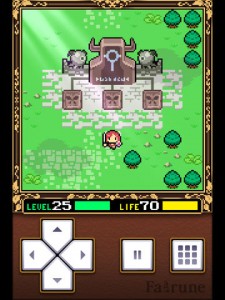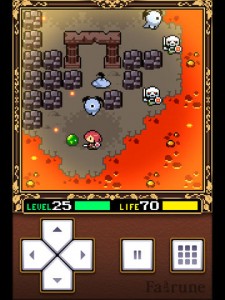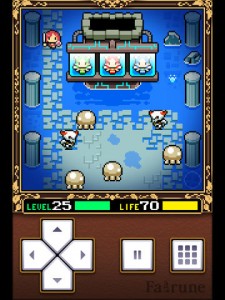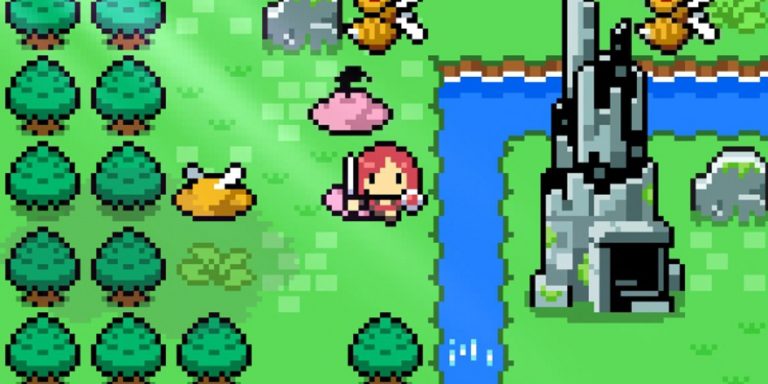I’m willing to bet — when asked about Action RPGs — that you initially think about Blizzard’s Diablo, or possibly something along the vein of Bethesda’s Elder Scrolls. What I’m guessing you don’t think about are the bygone classics: Hydlide, Gateway to Apshai, the highly experimental Dragon Slayer series, or even the numerous Ys games (and almost all of these predate the release of Nintendo’s famous Legend of Zelda). While I would personally think of various games developed by the now defunct Quintet — such as Act Raiser, or Illusion of Gaia — it would certainly seem that Skipmore, the same man singlehandedly responsible for Drancia (our review), remembers those earlier titles.
 Skipmore’s Fairune (out now, free) aims to pay homage to a lost era where combat was abstracted, puzzles were aplenty, hints were almost nowhere to be found, plotlines were virtually nonexistent, and the graphics were always pixelated. Similar to Drancia before it, Fairune is also an updated — and vastly expanded — remake of an earlier flash-based game (once more built with the help of URARA-WORKS’ talented staff). Furthermore — in a rather amazing turn of events — this free game, which can actually take you many hours to finish — comes with absolutely no IAPs, and only a tiny ad on the title screen.
Skipmore’s Fairune (out now, free) aims to pay homage to a lost era where combat was abstracted, puzzles were aplenty, hints were almost nowhere to be found, plotlines were virtually nonexistent, and the graphics were always pixelated. Similar to Drancia before it, Fairune is also an updated — and vastly expanded — remake of an earlier flash-based game (once more built with the help of URARA-WORKS’ talented staff). Furthermore — in a rather amazing turn of events — this free game, which can actually take you many hours to finish — comes with absolutely no IAPs, and only a tiny ad on the title screen.
Anyways — getting back to topic — it would seem that you’re here because a giant talking book, known as the Ancient Codex, has summoned you to Fairune for an urgent matter. Apparently a terrible scourge was unleashed when the three Spirit Icons — responsible for sealing great evil — recently disappeared, and the Ancient Codex is hoping you’d be a nice enough person to go track the icons back down. You shouldn’t be alarmed — however — at this turn of affairs, for it seems that Fairune regularly misplaces these Spirit Icons every few hundred years (it’s their version of a tradition, according to the Ancient Codex).
Afterwards you’ll be dumped at the place where the three Spirit Icons once stood, and promptly be informed that you shouldn’t worry as the nearby monsters wouldn’t dare hurt a girl in a cute dress. From here you’ll begin exploring Fairune’s countryside using an on-screen D-Pad, with each of the four directions moving your heroine a single square when tapped (although you may additionally hold down a button for continuous motion). All too soon — during this peaceful walkabout — you’ll find a Mana Shard laying amongst some crumbling ruins, which the Ancient Codex — after mentioning that such things are needed for the restoration of your health — immediately orders you to snatch it up.
 Apparently HP Springs — which are places that instantly restore your health — can be created when you use this Mana Shard on curious tufts of grass, and the Mana Shard itself furthermore has infinite uses. The use of items — such as this Mana Shard — is as simple as hitting the inventory button, and then afterwards tapping any of the displayed items will attempt to use it on whatever you’re facing (or sometimes standing on top of). Coincidentally the activation of this initial HP Spring also causes a nearby briar patch to disappear, giving you free access to the sword — complete with heroic looking armor — that it formerly protected (and with this stuff collected, your cute dress is now forever gone).
Apparently HP Springs — which are places that instantly restore your health — can be created when you use this Mana Shard on curious tufts of grass, and the Mana Shard itself furthermore has infinite uses. The use of items — such as this Mana Shard — is as simple as hitting the inventory button, and then afterwards tapping any of the displayed items will attempt to use it on whatever you’re facing (or sometimes standing on top of). Coincidentally the activation of this initial HP Spring also causes a nearby briar patch to disappear, giving you free access to the sword — complete with heroic looking armor — that it formerly protected (and with this stuff collected, your cute dress is now forever gone).
Fairune’s brief tutorial portion then concludes by informing you that you’ll need to level-up many times in order to finish your quest, and furthermore that you can always check the Ancient Codex — via your item menu — in order to see which enemies are ideal for this. Now while the game is obviously going to suggest you first tackle those pathetic looking blue slimes, this task will be handled in a manner probably novel to younger gamers (unless — perhaps — they’ve spent time with some of Falcom’s recent Ys series remakes). Rather than pushing a sword button to bash your foes when they approach, you’ll instead charge heroically right towards them — or possibly even allow let them to carelessly bump into you — and afterwards watch as their squished remains collapse lifelessly to the floor.
For each of these defeated enemies you’ll receive a single point of exp, with both your level — as well as your monster tackling abilities — increasing whenever your exp gauge fills all the way (and it seems that all levels require precisely the same amount of exp). Unfortunately, you’ll also take damage from these collisions — unless the monster is utterly below you, at which point there won’t be any exp either — and this damage taken will even increase depending on just how much stronger this monster truly is. Finally, any monster that is two — or more — levels above your ideal target will prove utterly invincible against your heroic bumping (yet still be able to freely hurt you all the same).
 Thankfully — however — there’s plenty more to Fairune than just bumping into monsters, and afterwards running back to the nearest Mana Spring, as that would otherwise get boring rather quickly. More important than the monsters themselves will be the numerous dead-ends you’ll constantly find at every twist and turn, none of which can ever be solved merely by leveling up a few more times. These puzzles will instead need to be solved with your cunning, your careful observation of the surroundings, and with the numerous items you’re lugging around (and there’s never a penalty for using an item wrongly).
Thankfully — however — there’s plenty more to Fairune than just bumping into monsters, and afterwards running back to the nearest Mana Spring, as that would otherwise get boring rather quickly. More important than the monsters themselves will be the numerous dead-ends you’ll constantly find at every twist and turn, none of which can ever be solved merely by leveling up a few more times. These puzzles will instead need to be solved with your cunning, your careful observation of the surroundings, and with the numerous items you’re lugging around (and there’s never a penalty for using an item wrongly).
I don’t want to say too much about these puzzles, since solving them comprises most of the enjoyment found within, but you’ll definitely want to carefully observe the scenery when traversing Fairune. For instance — very early on — you’ll encounter a forest with a few trees that look different from all the others, and — after inspecting them further — you’ll discover that you can easily walk straight through these oddly appearing trees. You’ll additionally want to think about how the items you’ve gathered up are commonly used in real-life, because — rather than the MacGyver-esque solutions normally seen in Graphic Adventures — items are generally used in a fairly normal way over in Fairune.
At this point I’d like to remind people that Fairune — which I originally spent over four hours playing before initially completing it — is being offered for free, without any IAPs whatsoever, and only a single advertisement running on the game’s primary title screen. As a result, there’s really no reason why anyone — whom claims to be a fan of older Action RPGs (back when people were expected to solve puzzles without going online) — shouldn’t pick this game up immediately. Furthermore, there’s even replay value for those whom aim to go back and track down every last rare monster — find all of the super-hidden powerful treasures — or even to just improve their over-all completion time.
About the only problem I could find with Skipmore’s Fairune would be that the game sometimes crashes when attempting to initially boot it up, but this issue is otherwise inconsequential as opening the App a second time generally solves everything.
Verdict
Fairune is a loving-tribute to early era Action RPGs — such as Dragon Slayer, Hydlide, or even Ys — with simple controls, bump-action combat, a limited storyline, and puzzles that often demand you pay close attention to the scenery. It’s actually rather impressive that hours of exploration-driven action — coupled with high quality retro-pixelated graphics, alongside quality chip tunes — could be offered for absolutely free, all with no IAPs or obtrusive ads constantly getting in the way. Clearly anyone whom is a fan of hyper old-school Action RPGs — retro pixelated graphics — or just solving tons of classic-style puzzles should check this game out, and –with an utterly free price tag — it wouldn’t hurt everyone else to check it out either.


